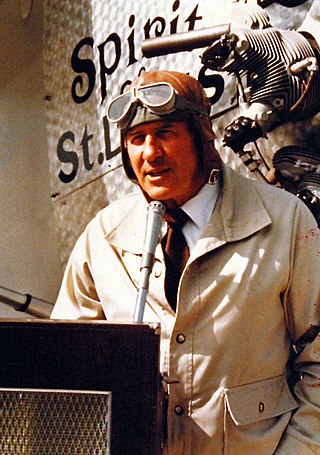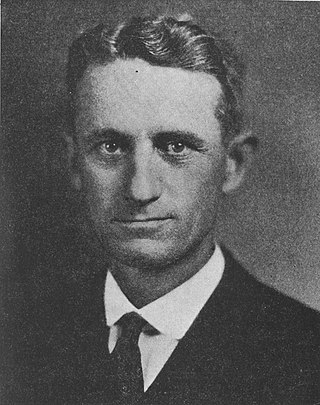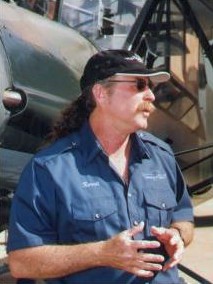Related Research Articles

The Experimental Aircraft Association (EAA) is an international organization of aviation enthusiasts based in Oshkosh, Wisconsin. Since its inception, it has grown internationally with over 300,000 members and nearly 1,000 chapters worldwide. It hosts the largest aviation gathering of its kind in the world, EAA AirVenture Oshkosh.

A warbird is any vintage military aircraft now operated by civilian organizations and individuals, or in some instances, by historic arms of military forces, such as the Battle of Britain Memorial Flight, the Royal Australian Air Force's No. 100 Squadron, or the South African Air Force Museum Historic Flight.

Peter M. Bowers was an American aeronautical engineer, airplane designer, and a journalist and historian specializing in the field of aviation.

The Ace Baby Ace, a single-seat, single-engine, parasol wing, fixed-gear light airplane, was marketed as a homebuilt aircraft when its plans were first offered for sale in 1929 — one of the first homebuilt aircraft plans available in the United States. Plans are still available and Baby Aces are still being built. Orland Corben designed a series of aircraft for the Ace Aircraft Manufacturing Company, the Baby Ace, Junior Ace, and Super Ace. Corben's name was associated with the aircraft, and it is commonly known as the Corben Baby Ace.

Paul Howard Poberezny was an American aviator, entrepreneur, and aircraft designer. He founded the Experimental Aircraft Association (EAA) in 1953, and spent the greater part of his life promoting homebuilt aircraft.

Katherine Stinson was an American aviation pioneer who, in 1912, became the fourth woman in the United States to earn the FAI pilot certificate. She set flying records for aerobatic maneuvers, distance, and endurance. She was the first female pilot employed by the U.S. Postal Service and the first civilian pilot to fly the mail in Canada. She was also one of the first pilots to ever fly at night and the first female pilot to fly in Canada and Japan.

Giuseppe Mario Bellanca was an Italian-American aviation pioneer, airplane designer and builder, who is credited with many design firsts and whose aircraft broke many aviation records. He was inducted into the National Aviation Hall of Fame in 1973. The Bellanca C.F., one of the world's first enclosed-cabin monoplanes, is on display at the National Air and Space Museum. Bellanca was known mostly for his long range aircraft which led the way for the advancement of international and commercial air transportation.

Winfield Bertrum "Bert" Kinner was an American aircraft engine designer and designer of the first folding wing aircraft. Kinner founded Kinner Airplane & Motor Corporation in Glendale, California, which produced radial engines and aircraft.

Kermit Weeks is an American aviation enthusiast, pilot, and aircraft collector. He has competed in aerobatics, designed aircraft, and promoted aviation and vintage aircraft restoration.

Edward Anderson ("Eddie") Stinson, Jr. was an American pilot and aircraft manufacturer. He was the founder of Stinson Aircraft Company, one of America's first manufacturers of enclosed-cabin aircraft, and commercial airliners. At the time of his death in 1932 in an air crash, he was the world's most experienced pilot in flight hours, with over 16,000 hours logged.

The Spartan 7W Executive is a cabin monoplane aircraft that was produced by the Spartan Aircraft Company during the late 1930s and early 1940s. The 7W features an all-metal fuselage, as well as a retractable undercarriage. The 7W Executive was popular with affluent buyers worldwide.
The American Aviation Historical Society (AAHS) is a non-profit organization "dedicated to the preservation and dissemination of [the history of] American aviation." AAHS has had an educational program in promoting American aviation through its journal and a periodic newsletter, archives historical aviation documents and photos, maintains multiple websites on aviation history, and assists aviation historians and the public in the acquisition and exchange of aviation history information.

The Historic Aircraft Restoration Museum, located at Creve Coeur Airport in Maryland Heights, Missouri, United States, is dedicated to restoring and preserving historical aircraft. The airplanes in the collection are all fabric-covered, and most are biplanes from the inter-war years. The museum's volunteers maintain most of these aircraft in full working order.

The Alaska Aviation Museum, previously the Alaska Aviation Heritage Museum, is located on Lake Hood Seaplane Base in Anchorage, Alaska. Its mission since 1988, is to preserve, display, and honor Alaska's aviation heritage, by preserving and displaying historic aircraft, artifacts, and memorabilia, and to foster public interest in aviation and its history. The museum has over thirty aircraft on display, a restoration hangar, flight simulators, two theaters, and a Hall of Fame. It provides an emphasis on historic aircraft, aviation artifacts, and memorabilia that contributed to the development and progress of aviation in Alaska, including Bush flying, and the World War II Army base on Adak Island.
Star Air Service, later Star Air Lines and Alaska Star Airlines was an American air service in Alaska from 1932 to 1944. With financial help from a wealthy Alaska miner, three pilots who had started a flying school and charter business in Seattle, shipped an open-cockpit biplane by steamship to Alaska in March 1932. Star Air Service was incorporated in April, 1932 in Anchorage with capitalization of $4,000. The company had some early success training student pilots, but their airplane was destroyed in a crash. Their financial backer helped them purchase a larger plane with an enclosed cabin which supported winter operations.

Aviation in Wisconsin refers to the aviation industry of the American Midwestern state of Wisconsin.

The U. S. Centennial of Flight Commission was created in 1999, by the U.S. Congress, to serve as a national and international source of information about activities commemorating the centennial of the Wright brothers' first powered flight on December 17, 1903.
The Golden Wings Flying Museum was an aviation museum located in Blaine, Minnesota.
The International Stinson Club is an organization of pilots, mechanics, and other aviators that is dedicated to flying, maintaining, and sharing knowledge of airplanes built by the Stinson Aircraft Company.
References
- 1 2 3 4 5 6 7 8 9 "2011 Hall of Fame Inductee-John Underwood," December 2011,Vintage Airplane (copied), Vintage Aircraft Association Hall of Fame, Experimental Aircraft Association (EAA); also at "Previous Inductees," Vintage Aircraft Association Hall of Fame, EAA, retrieved September 26, 2022
- 1 2 3 4 5 "The Descriptive Finding Guide for the John Underwood Photographic Collection SDASM.SC.10146," at San Diego Air and Space Museum Library and Archives, as recorded June 2016, at Online Archives of California, retrieved September 26, 2022
- 1 2 3 4 5 6 7 8 9 "John Underwood Hall of Fame Inductee," 4th Quarter 2011, AAHS Flightline, fl-177, American Aviation Historical Society, retrieved September 26, 2022
- 1 2 3 Wood, Janice: "EAA to induct five into Hall of Fame," October 16, 2011, General Aviation News, retrieved November 2, 2022
- 1 2 O'Keefe, Mary: "Revisiting Airline History," February 2, 2007, Glendale News-Press, retrieved September 26, 2022
- 1 2 Underwood, John W.: "John Underwood Comments," "News and Comments from Our Members," Spring 2021, AAHS Journal, American Aviation Historical Society, retrieved September 26, 2022
- 1 2 3 4 5 6 7 "AAHS 60th Anniversary Annual Meeting," 1st Quarter 2016, AAHS Flightline, (fl-192), p.6, American Aviation Historical Society, retrieved September 26, 2022
- ↑ "President's Message," Spring 2016, AAHS Journal, Vol. 61, No. 1, American Aviation Historical Society, retrieved September 26, 2022
- 1 2 3 4 5 6 "Introducing The Members," April–June 1956, American Aviation Historical Society Journal, Vol. 1, No. 2, p. 57, American Aviation Historical Society (AAHS).
- 1 2 "John Underwood Photographic Collection," San Diego Air and Space Museum, retrieved September 26, 2022
- 1 2 "The 116/616 Photographers", Aerofiles.com, (Underwood listed at ), retrieved September 26, 2022
- ↑ "Alden Brown B-1," in "Famous Record Breaking and Racing Aircraft," Air Racing History website, retrieved November 2, 2022
- ↑ photo: "Alden Brown Racer," "Willam F. Yeager Photographs," Special Collections, Wright State University, retrieved November 2, 2022
- ↑ Search for "Underwood", (several pages of search results), website of the American Aviation Historical Society, retrieved September 26, 2022
- ↑ masthead: "Editorial Staff," October 1998,Vintage Airplane, Vol. 26, No. 10, Vintage Aircraft Association, Experimental Aircraft Association (EAA), retrieved September 26, 2022
- ↑ "Volmer Jensen's New Pop-Rivet, Snap-Lock, Strap-On Glider," November 1974, Sport Aviation, Vol. 23, No. 11, Experimental Aircraft Association (EAA), retrieved September 30, 2022
- ↑ Underwood, John: "Famous Names in Aviation ...Stinson," Oct/Nov 1963, Air Progress
- ↑ "Magazine Contents Lists: Page 291," The FictionMags Index, retrieved September 29, 2022
- ↑ Freeman, Paul: "California: Central Los Angeles Area," Abandoned & Little-Known Airfields, 2002, 2022, retrieved September 26, 2022.
- ↑ "KREUTZER TM 4 NX71E," (photo credits) Davis-Monthan Airfield Register Website, retrieved September 26, 2022
- ↑ Westin, Larry: "The Stinson 108 Voyager Bibliography," January 28, 1996; rev. 30, December 7, 2010, The Stinson 108 Voyager and Flying Station Wagon Page, retrieved September 26, 2022
- ↑ "Credits," October 1990, Lindbergh, PBS/American Experience, retrieved September 26, 2022
- ↑ Underwood, John: "Search: John Underwood, Air and Space Museum, Collection Images", images (including scanned or photographed text documents), National Air and Space Museum, retrieved September 26, 2022
- ↑ Underwood, John, with Auguste Bellanca and Dorothy Bellanca: "Possibilities For Books on Bellanca, John Underwood, 1961–1973 ", National Air and Space Museum (images of correspondence), retrieved September 26, 2022
- ↑ "John W. Underwood, 1966–1967, 1970–1976," Box 19 of 73, Collection Overview: Record Unit 330: National Air and Space Museum. Department of Aeronautics: Correspondence, 1965–1986", retrieved September 27, 2022
- ↑ "John Underwood, 1972 – 1980", File – Box: 18, Folder: 11, in "Series IV: Correspondence, 1930 – 1988," William F. Yeager Aviation Collection (MS-223), Special Collections and Archives, Wright State University Libraries, Wright State University, retrieved September 26, 2022
This article needs additional or more specific categories .(October 2022) |